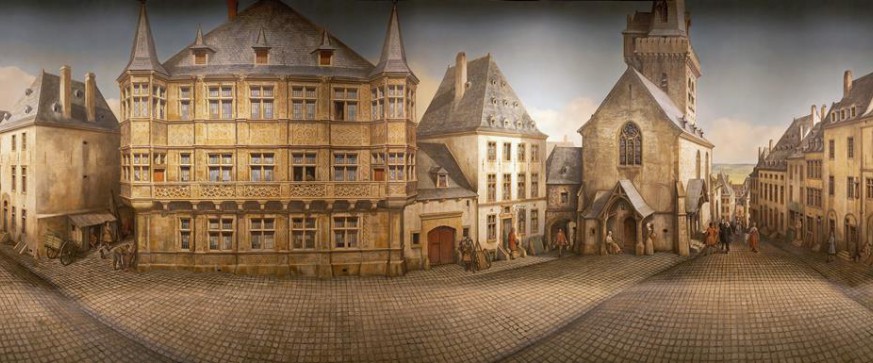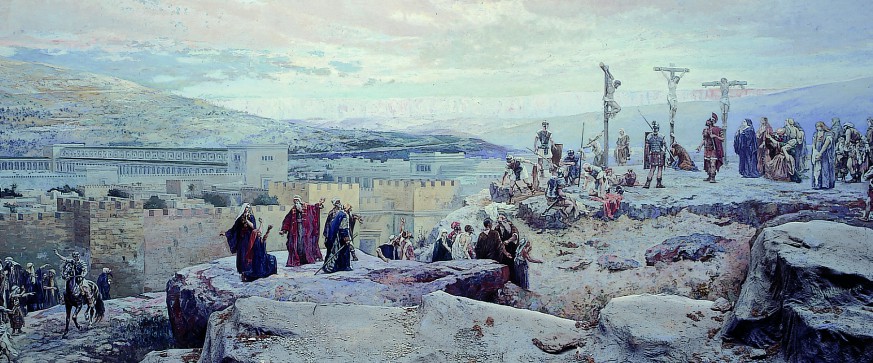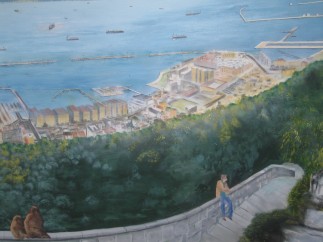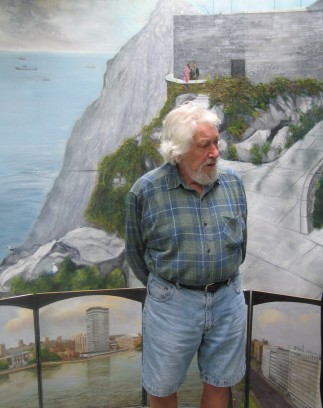Roger Hallett who has died on 1 August 2018 at Salies de Béarn in South-West France at the age of 89 was a British painter and as a panorama artist unique at a time when the knowledge of how to paint panoramas had almost completely been forgotten in the artistic world.
- Panorama Rouen 1431
created by Yadegar Asisi in 2016
photo © asisi.jpg)
- Panorama Rotunda by Hittdorf
Paris, France in 1838 - Panorama of the Entry of the Magyars / Feszty-Panorama
Opusztaszer, Hungary
© Patrick Deicher - The City of Luxembourg in the 17th century (Artist: Antoine Fontaine)
Musée d'histoire de la Ville de Luxembourg, Luxembourg
© MHVL, Falk Eisleben
- Semi-circle Panorama 'The Berlin Wall' created in 2012 by Yadegar Asisi, © asisi, Tom Schulze
.jpg)
- e-cyclorama by Sanford Wurmfeld
exhibited in Edinburgh, Scotland in 2008.jpg)
- Jerusalem Panorama Crucifixion of Christ, Altötting, Germany, © Stiftung Panorama Altötting / photo H. Heine
.jpg)
- Wilpena Panorama created by Jeffrey B. Morgan, Hawker, Australia
- Diorama of the Conquest of Constantinople in 1453
Military Museum, Istanbul, Turkey
© Patrick Deicher - ICCI 360 Rotunda
seamless 360° film projection in a mobile rotunda
ICCI (Innovation for the Creative and Cultural Industries) with Plymouth University, UK
© Patrick Deicher.jpg)
- Panorama of Jerusalem and the Crucifixion of Christ, Einsiedeln, Switzerland

- Panorama Raclawice
Wroclaw, Poland
© Patrick Deicher
- Panorama of The Battle of Waterloo
Braine l'Alleud, Belgium
© Patrick Deicher.jpg)
- Interactive electronic panorama
exhibited in Luzern, Switzerland in 2010
© Patrick Deicher.jpg)
- Panorama of the City of Salzburg (Sattler-Panorama)
Salzburg, Austria
- Panorama of the Palace and Gardens of Versailles
Metropolitan Museum of Art, New York, USA
© Patrick Deicher
- Panorama of the Chibi War in 208
Wuhan, China
- Panorama of the Battle of Pleven
Pleven, Bulgaria
© Patrick Deicher
- Panorama of the Battle of Ji Nan
Ji Nan, China
- Panorama of the Battle of Mount Isel
TirolPanorama, Innsbruck, Austria
© Patrick Deicher
- Bourbaki Panorama
Luzern, Switzerland
© Emanuel Ammon.jpg)
- News
- In Memory of Roger Hallett (1929 – 2018)
In Memory of Roger Hallett (1929 – 2018)
Sunday, 09 September 2018To members of the IPC he will be remembered for having attended several panorama conferences. It was on the occasion of a panorama conference in Altötting, Germany, in 1998 that I first met Roger Hallett and got to know his panoramic work.
Born in Bristol, UK, on 1 June 1929, Roger Hallett attended Bristol Cathedral School and then worked for a Bristol architect. After having finished his National Service in the army he studied at the Slade School of Art in London to become a professional artist. He then emigrated to Australia where he worked as a scenic artist for television in Sydney and as a set designer in Melbourne. Back in England in 1960 Hallett taught painting and drawing at the Cathedral School in Wells, and at the Royal West of England Academy in Bristol. During one of the painting holidays in the Netherlands to which he used to take groups of amateur artists he visited Panorama Mesdag in The Hague which shows the Dutch seaside at Scheveningen. Hallett was overwhelmed by the artistic beauty of this panorama painted by Hendrik Willem Mesdag in 1881.
Inspired by Mesdag’s panorama Hallett decided to paint his own panorama and as a subject chose his home town of Bath as seen from a balloon. The painting took four years, and was completed in 1987. The Panorama of Bath was seven metres high and 70 metres long. It had a faux terrain which consisted of around 80 clay figures which were created by Hallett’s students. To paint the panorama Hallett used a room in a former factory. As the canvas could not be hung in its entire length the artist built a construction with spools on both sides which would hold a section of the canvas between them. When a section was finished the canvas was wound from one onto the other spool. Winding on the canvas had to be done four times until the whole work was completed. Each quarter took a year to paint. The panorama was opened in 1987 in London in Jubilee Gardens, South Bank, in a rotunda designed by engineer Ian Liddle from Bath. From 1988 until about 1995 it was exhibited at the Thames Barrier at Charlton.
In 1999 Hallett started to paint a new panorama depicting the lovely small town of Salies de Béarn in South-West France where he lived since 1993. Being small in size – just two and a half metres high and 12 metres long – the panorama was on exhibition in the town’s former tourist office from 2000.
In 2004 the artist exchanged the Panorama of Salies de Béarn for a panorama depicting Gibraltar. In September 2009 I visited the artist in Salies de Béarn and saw his Gibraltar panorama. I was surprised by how well everything worked in this panorama. It showed Gibraltar in breathtaking perspectives – amazing for its small size. The building in which the panorama was exhibited was so small that the visitor when entering the building through a door on the ground floor found himself right in the centre of the panorama painting. With a touch of genius Hallett made the floor an integral part of the panorama extending the depiction of the panorama to the floor thus making the viewer part of the picture. He also introduced some eye-catching details such as the door handle formed as a ship, or the famous monkeys of Gibraltar watching a visitor. The illusion of ‘being in the picture’ was as perfect as in one of the large classical panoramas of the 19th century. The Gibraltar Panorama clearly was the work of an artist who had extensive knowledge of painterly perspective and who knew how to use it in the right way in order to create a convincing work of art. It was shocking news that just a few months after my visit to Salies de Béarn the panorama was removed from the building and that it was destroyed. Gibraltar was Hallett’s last panorama and certainly it was one of his best.
The artist had ideas for more panoramas. There were plans for a panorama of Lourdes, the Marian pilgrimage not far away from Salies de Béarn, of which he presented the model in three panels, 52 x 65 cm each, at the International Panorama Conference in Szeged, Hungary, in 2000. Hallett also made preparatory studies for a panorama of Bordeaux.
Panorama historian Ralph Hyde who sadly passed away three years ago knew Roger Hallett for long and had accompanied his panoramic work from the start. In 2003 he convinced him to deposit the journals he kept when painting the Panorama of Bath with the Bath & North-East Somerset Record Office. They are important documents for researchers who wish to study panorama history. It is very much hoped for that Roger Hallett’s only surviving panorama, now in storage, the Panorama of Salies de Béarn, as well as his panoramic studies will be preserved for the future. With these works Roger Hallett has made an important contribution to the history of panorama painting.
A great part of the biographical information in this text is drawn from Ralph Hyde’s article, ‘Roger Hallett. Panorama Artist’, published in The World of Panoramas: Ten Years of International Panorama Conferences (2003). For the updates my thanks go to Malcy Lamotte d’Incamps and to Roger Hallett’s daughter Dido.
—Gabriele Koller

.jpg)

